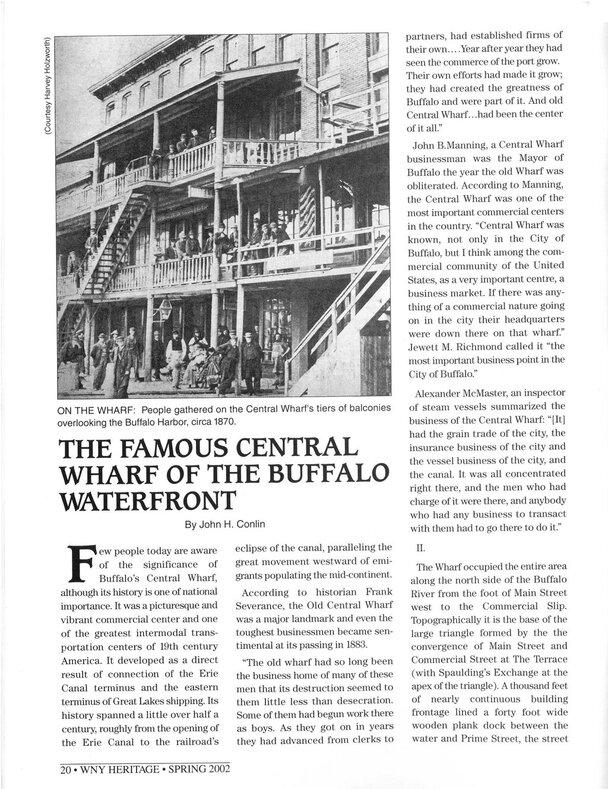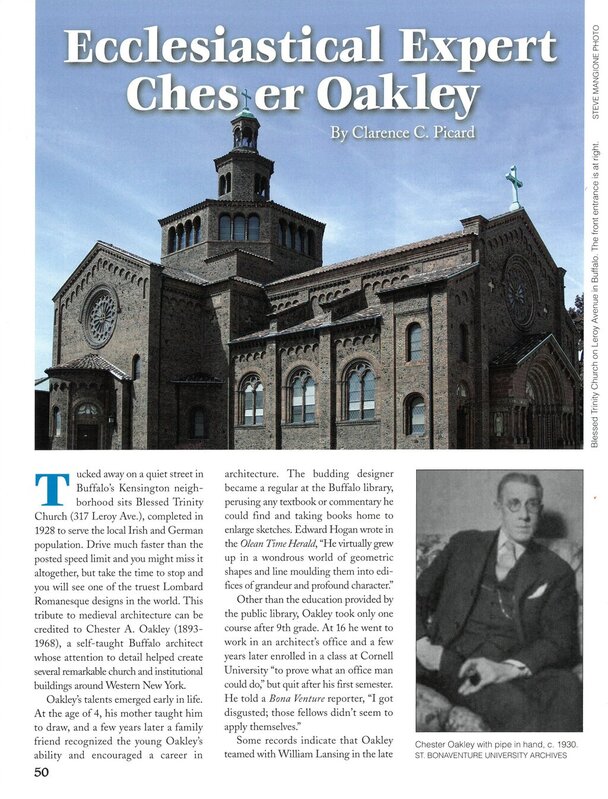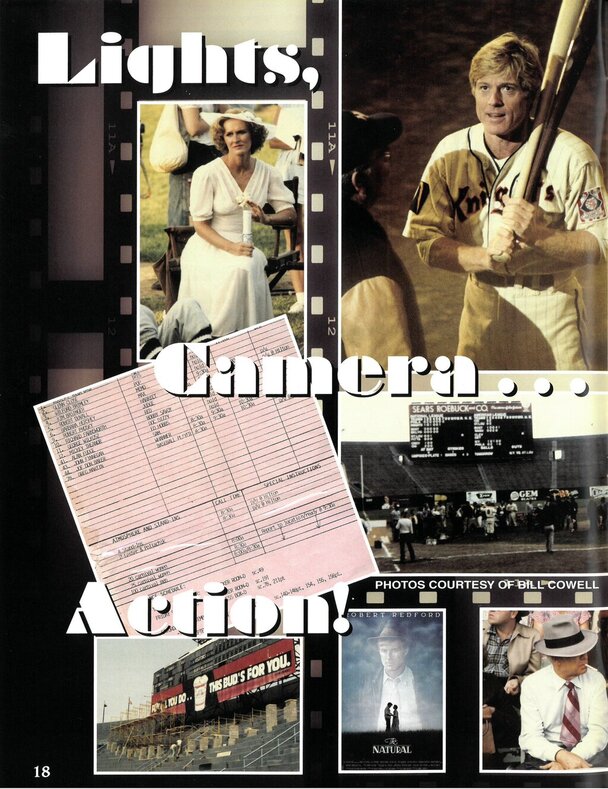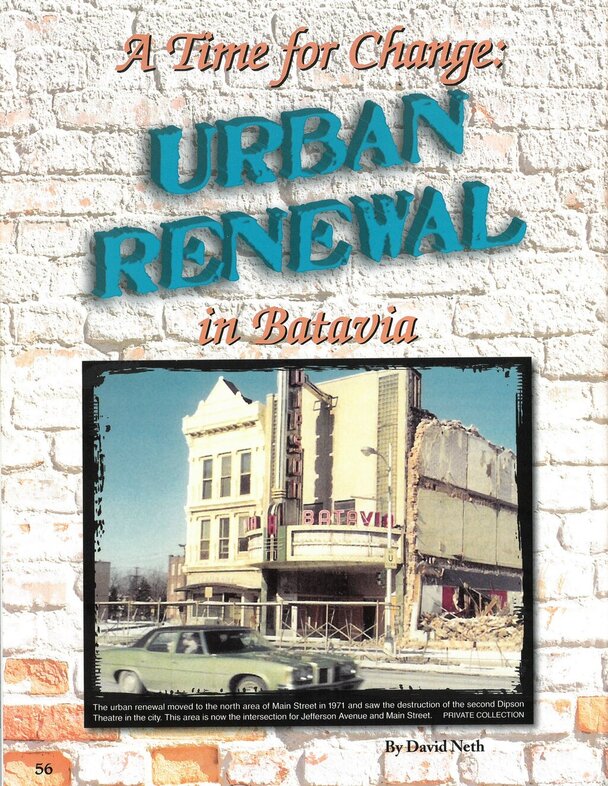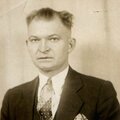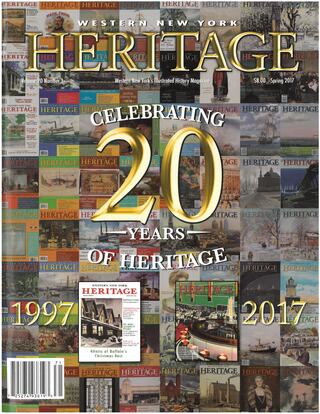
The first issue of Western New York Heritage (left) appeared in late 1997. At right, our current issue, 20 years later.
It was December 1997 and the place was the Burchfield Gallery on the Buffalo State College campus. A press conference announced the debut of something heretofore unheard of in Western New York—a magazine devoted to the region’s history. The inaugural cover appropriately featured a painting by Charles Burchfield, and inside were stories on the Prince melodeons, the Albright mansion, Irishwoman Julia Hogan and others.
First published by the Western New York Heritage Institute, the new Western New York Heritage magazine would weather a rocky beginning. Two more issues were published in 1998, with a third coming in 1999. That year the “Institute” was dissolved and its successor, Western New York Heritage Press, introduced a “new and improved” publication, thanks to valuable partnerships with the Margaret L. Wendt Foundation and the Baird Foundation—treasured relationships which continue, albeit in altered form, to this day.
The struggle to keep the momentum going for this novel experiment continued, with only two more issues appearing in the next two years. Beginning with 2002, however, the magazine began to appear on a regular quarterly basis, and with the exception of one “dual season” issue, has never looked back. Over the ensuing years, there have been only two executive editors, along with several assistant editors, each contributing in unique ways to the evolution of the publication and the organization. On the occasion of our 20th year of publication, we present a brief look back from the perspectives of some of our editorial staff, past and present.
John Conlin - Editor Winter 1999-Spring 2009
John brought his passion for architecture, as well as the region’s rich and varied history, to the task of revitalizing the magazine when his name graced the masthead as editor in the Winter 1999 issue. While he acknowledged the fact that creating the magazine constituted “new territory,” as more people learned of the publication by spring 2002 he was able to report that, “it is beginning to have an effect—to make a difference.” John accurately sized up his audience as one “interested in the history of this place, waiting to learn and share more.” When later some would suggest “edgier” content for the magazine, John stood his ground, succinctly stating a view of his audience that remains a cornerstone of the organization: “I believe this magazine should be thought-provoking but never strident, acerbic or polemical. Knowledge and education are ends in themselves. We have chosen to respect the native intelligence and judgment of our readers.”
Slowly, but surely the number of subscribers increased, and by summer of 2004 John dubbed the magazine “the fastest-growing cultural entity in the region.” With readership growth and other improvements came recognition from other sources. In 2007, Western New York Heritage Press received the Friends of Architecture Community Service Award from the local chapter of the American Institute of Architects, while Dual Printing, who prints the magazine, received the Superb Printing Award from the Buffalo and Rochester Clubs of Printing House Craftsmen. In 2009 the magazine would receive an award from Preservation Buffalo Niagara for “ten years of promoting knowledge, interest and dedication to local history and historic architecture in Western New York.”
John Conlin retired as editor with the Spring 2009 issue, but hallmarks of his tenure still resonate in the Western New York Heritage of today. These include covers that feature relevant artwork, not photographs, and content that is unique and authoritative, yet accessible—and always illustrated.
Clarence Picard - Assistant/Associate Editor Summer 2006-Summer 2011
I didn’t have your standard introduction to life in Buffalo. As an undergrad at St. Bonaventure I loved the area, and the people were welcoming, but I was not a Western New Yorker.
But I can clearly identify the moment when I started my path to becoming one; when, in a single day in late-Spring 2006, John Conlin interviewed me at The Edge of Town restaurant over beef-on-weck sandwiches and beers, and hired me as his assistant editor, officially making me a professional journalist.
My immersion into the region’s history started immediately, editing a cover story on Mary Jemison for the Summer 2006 issue. Going through the archives brought back a flood of memories, but several personal highlights stand out from those years:
- helping arrange photo-essays of the Heath House (Fall 2006), Graycliff (Fall 2007) and the Central Terminal (Spring 2009);
- working with Mr. Conlin and Deanna Rusek to further develop the magazine’s design aesthetic, with the seven-issue run from Spring 2009 to Fall 2010 being a favorite;
- and learning from and working with great people like Janet Wetter, Russell Baker, Ann Graham and Doug DeCroix, as well as several members the magazine’s board and the great people at Printing Prep and Dual Printing.
Notably, a feature on Chester Oakley, designer and architect of Blessed Trinity and many prominent buildings on the St. Bonaventure campus, helped get my foot in the door with the SBU marketing department, where I would go on to work.
However, none of those stories gave me the same feel for the city as driving around with Mr. Conlin, hearing stories of old Buffalo, buildings he helped preserve, and others that were lost to the wrecking ball.
Congratulations to everyone involved for reaching this milestone!
Matthew Biddle - Assistant Editor Fall 2011-Winter 2014
When anyone asks about my time at Western New York Heritage, I always tell them the same thing: I learned more about the history of our region in those two-and-a-half years than I did before or after. I’ve always loved admiring our region’s beautiful architecture, but by working on the magazine, I gained a deeper appreciation of our rich history. In my first issue alone, Fall 2011, we highlighted Louise Bethune, the world’s first female professional architect, who designed the Lafayette Hotel in Buffalo.
Some of my favorite stories from my tenure were the early history of my hometown, West Seneca (Spring 2012), an homage to the Playboy Car Co. written by the founder’s grandson (Summer 2012), the story of crusading reporter A.J. Smitherman (Winter 2013) and a celebration of artist Amos Sangster (Fall 2013). I enjoyed working with our passionate volunteer writers to shape their stories, as well as visiting libraries and archives to find photos, maps and other imagery to illustrate them.
Of course, I also got to research and write my own features—visiting the Concord Historical Society to research songwriter Jack Yellen (Winter 2012), photographing the stunning E.E. Boynton House in Rochester (Summer 2012), stepping inside the magnificent and sadly since-demolished Jefferson Avenue Shul (Fall 2012) and chronicling Buffalo’s long film history (Summer 2013). As a big movie buff, I most enjoyed researching that last story—but, honestly, each piece I wrote or edited was fascinating in its own way.
In Winter 2012, we introduced Endnotes, the back-page column, as a way to update past stories, spotlight organizations or cover a shorter piece of history. We also experimented with the cover; each featured an artwork, but the tone varied, from the gloomy Sangster etching on Fall 2013, to the vibrant H.H. Crawford waterfront painting on Spring 2013 (my favorite), to Winter 2014, my last issue, when we just couldn’t decide—and produced two collectible covers by painter Clara Langenbach.
It’s been a great 20 years for Western New York Heritage—and I can’t wait to see, and read, what comes next.
David Neth - Assitant Editor Spring 2014-Present
I joined the Western New York Heritage team in the spring of 2014, straight out of graduate school. With no prior knowledge of the organization, I spent the next few months devouring back issues. Very quickly I learned all about the history of our region. Many of the stories I hadn’t heard before, while of others I had only heard parts. Reading about things like the growth of Buffalo, the rise and fall of the Larkin Company or Ellsworth Statler was inspiring and continues to serve as a reminder that our lives today will be the focus for future historians.
Among the many stories I’ve worked on in my three years here, my favorites are the rags to riches stories like John R. Oishei, Glenn Curtiss or Emily McDonnell, as well as the stories behind the many buildings and businesses that are still a part of our lives today. As for the articles I’ve written, sharing the story of Batavia’s urban renewal and the life and legacy of William Pryor Letchworth were the most fun to work on.
I look forward to helping the organization move forward in its next decade as we look at ways to become more active in the digital world, while continuing to share the stories of the region’s history.
Douglas DeCroix - Executive Editor Spring 2009-Present
It was my good fortune to be chosen to succeed John Conlin as editor at Western New York Heritage in the spring of 2009. It would have been hard for me to imagine a more positive transition experience, as John was (and is) incredibly supportive and left me with a solid, veteran staff and a fantastic magazine upon which to build.
In the last eight years, with the help of a fantastic staff, invaluable technological partners and a dedicated board of directors, I have tried to begin writing the next chapter in the Western New York Heritage story. We have made efforts to modernize the magazine, both in terms of appearance and content, while maintaining the solid reputation for quality and authority that John worked so hard to establish. And as we move further into the digital age, we have made strides to improve and expand our online presence, while looking to the future and what it holds for us.
To choose a favorite story or experience here is a real challenge, as it has been my privilege to work with so many wonderful people on so many fascinating topics. Each has been—and continues to be—a unique experience. For my own work, anything focused on aviation rises quickly to the top of the list, and being able to share the story of the P-39 fighter’s return to the region [“From Russia—With Log,” Fall 2009] about the time I took over was fantastic. But projects like our War of 1812 series, the Chez Ami, the Buffalo Launch Club, artist Norman Maffei and the Chautauqua Grape Belt have all meant working with incredible people on great stories—many of which would never have found a voice in any other publication—and that is the kind of thing that inspires me and makes me want to come to work in the morning.
Twenty years is indeed a milestone, but we look forward to what the next 20 years has in store—for both Western New York Heritage, and our region in general. And as all our editors, past and present, would surely agree—there are an endless number of stories still out there, just waiting to be told. Stay tuned!!
